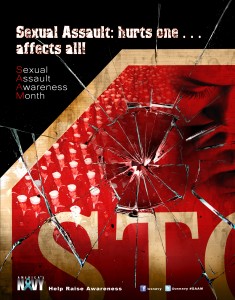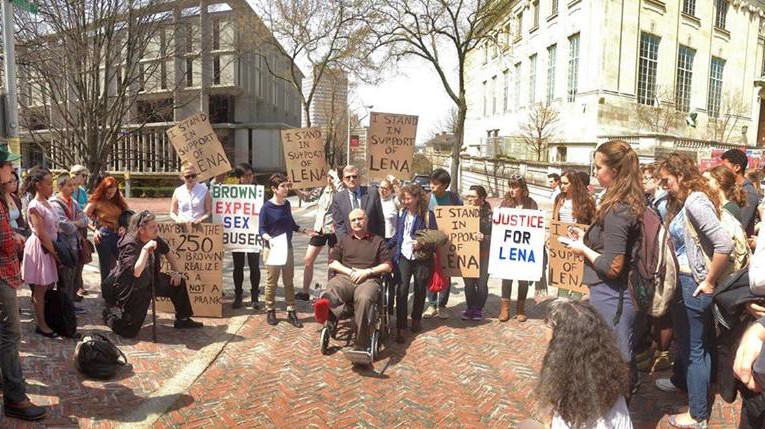The White House has officially donned its white hat. The highly anticipated First Report of the White House Task Force to Protect Students from Sexual Assault was released yesterday. The interagency task force, which falls under the purview of the White House Council on Women and Girls, is fronted by Vice President Joe Biden, US Attorney General Eric Holder, Secretary of Education Arne Duncan and other department heads.
By involving the federal government, the report aims to call national attention to sexual assault on college campuses and strengthen the fight against sexual violence. Recent statistics reporting alarming numbers have likely sparked the motivation behind these efforts: At least 1 in 5 women will be sexually assaulted during her college years. And more often than not, the perpetrator is someone victims know or even trust. The monster myth is exactly that—a myth.
On creating the Task Force, President Barack Obama comments, “Sexual violence is more than just a crime against individuals. It threatens our families, it threatens our communities; ultimately, it threatens the entire country. It tears apart the fabric of our communities. And that’s why we’re here today – because we have the power to do something about it as a government, as a nation. We have the capacity to stop sexual assault, support those who have survived it, and bring perpetrators to justice.”

The White House’s report can be broken down into four components.
Identification
The Task Force has created a campus climate survey in hopes of more accurately understanding the extent of sexual assault on college campuses. This is thought to be a more efficient method of identification, as victims “rarely report sexual assault to law enforcement…[or] access formal services, like crises centers.” The survey is essentially a questionnaire meant to address “both the amount of sexual assault occurring (prevalence or incidence) and perceptions of campus climate.” It will be administered to students, faculty, staff, and/or administrators.
Prevention
The Centers for Disease Control and Prevention (CDC) has outlined the most promising prevention methods. In general, they are “those that are sustained (not brief, one-shot educational programs), comprehensive, and address the root individual, relational and societal causes of sexual assault.” Bystander intervention has been named as the most effective strategy. The CDC has published a basic factsheet regarding bystander intervention.
Sociological research demonstrates that men might not necessarily understand what other men consider acceptable sexual behavior. They will, in general, underestimate their peers’ desire to interfere in instances of sexual misconduct, thus making them less likely to intervene themselves.
A Public Service Announcement, emphasizing the idea that consent should be the determining factor in proceeding onwards in a sexual encounter, was also released this week.
Finally, the Task Force recommends the constant development of new prevention strategies.
Response
While sexual assault is a crime punishable by a significant prison sentence, many survivors choose a university hearing over a legal trial, and so we should improve the process by which universities respond. Given the highly traumatic nature of sexual assault, confidentiality and sensitivity must be employed by all affiliates of the university who will be involved.
In order to guarantee these qualities, the Task Force recommends hiring trained advocates who “understand the dynamics of sexual assault and the unique toll it can take on self-blaming or traumatized victims” and highlighting these individuals to all campus members. The Task Force will also be providing universities with a sample protocol regarding reporting and confidentiality.
Transparency & Enforcement
Under Title IX of the Education Amendments of 1972, federally-funded schools are required to not only prevent sexual assault but also respond quickly and adequately when it does occur. The Task Force has made a recommendation to federal agencies in that they should work on bettering their coordination in fighting sexual violence conjointly and clarify university obligations under Title IX.
The Task Force also launched NotAlone.gov to more effectively disseminate resources and literature regarding sexual assault and increase communication between all the involved parties.
While I commend federal efforts in reducing sexual assault, I, along with others, must criticize the White Houses’ lack of a nuanced, sophisticated lens. The report is largely based on a gender-normative dichotomy in which women get raped and men do the raping.
Yes—our current knowledge of rape points to the notion that women are sexually assaulted far more often than men and that the majority of rapists are men. However, our leaders must diversify their understanding of rape and its intersectionality in order to best provide solidarity and support to any survivor, regardless of identity.
As Brown student Lena Sclove puts it, “Right now there is a great deal of national attention on college sexual assault, but sexual assault happens in the home, in elementary, middle, and high school and on the street. A college education is inherently a privilege so we have to remember survivors who do not fit into the demographic of ‘college student’.”
Much like Capitol Hill, and perhaps due in part to our actions on the ground, Brown University has recently been enveloped by an air of increased concern for collegiate sexual assault. Last week we learned of the violent rape and strangulation of Lena Sclove that took place on August 2, 2013.
After a Student Conduct Hearing on October 11, 2013, the accused was found guilty of four violations under the Student Code of Conduct: actions that result in or can be reasonably expected to result in physical harm to a person or persons; sexual misconduct that involves non-consensual physical contact of a sexual nature; sexual misconduct that includes one or more of the following: penetration, violent physical force, or injury; and illegal possession or use of drugs and/or alcohol and/or drug paraphernalia.
The disciplinary board suggested a two-year suspension, but Senior Associate Dean for Student Life Allen Ward reviewed the case and, on his own accord, decided that a one-year suspension was more apropos. Sclove immediately appealed the decision but was rejected. The perpetrator remained on campus until the days before Thanksgiving break, thus reducing his suspension to a sole semester.
In the weeks after finals, Sclove awoke to find a painful lump on her back, which, unfortunately turned out to be a cervical spine injury that would render her unable to walk for months—one of the many life-altering side effects of the assault. She was forced to take a semester of medical leave and will, once her health improves, consider returning to Brown if significant policy change is evident. While away from campus, Sclove reported the incident to the Providence Police Department for the first time.
This hard-to-bear information rocked Brown University last week when it was revealed during a press conference in front of the Van Wickle gates. Student activists immediately rallied behind Sclove. Demonstrations and protests were rampant on our campus, reminding some that the ‘90s revolution is far from over. Two petitions were circulated asking signatories to stand in solidarity with the request that, upon determining a student guilty of sexual misconduct, Brown should suspend said student for two years, or until the victim graduates—whichever renders a longer punishment.
Upon release of Brown University President Christina Paxson’s sugarcoated statement and the Task Force’s initial report, students have altered the course of the movement.
New demands have been made. They are specific, concrete, and tangible. If implemented, Brown will, for the first time, privilege victims over perpetrators. Sclove’s testimony will, hopefully, be the final push for the university, which has been accused of softly punishing sexual assault in the past.
And while Sclove is arguably the current face of the fight against sexual assault at Brown, she is forever adamant that she is merely one of many. “This is not just about me,” she said in an electronic correspondence. “There are so many survivors out there. This is about all of us. This [is] about making this campus safe for everyone.” “But,” she points out, “we have to keep thinking critically about this issue. We can’t get stuck. We must think intersectionally about how sexual assault directly connects to racism, homophobia, transphobia, and classism.”
Lena, while “grateful to all the support” notes “there is still much to be done.”

I think it would be good to give Cynthia Fong ’14 credit for the panoramic photo used in this article.
Juhee, thanks for letting us know! The photo has been updated to credit Cynthia.